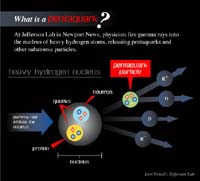The SAPHIR collaboration at the ELectron Stretcher Accelerator (ELSA) in Bonn, Germany, announced at the beginning of August evidence of the pentaquark from data they took in 1997/98. The SAPHIR collaboration announced evidence for Theta-plus with a mass of 1540 MeV and a width of less than 25 MeV, compatible with experimental results from SPring-8, ITEP and Jefferson Lab.
The SAPHIR Collaboration paper is available at http://arXiv.org/abs/hep-ex/0307083 One member of the SAPHIR Collaboration is Fritz Klein, who is also a current member of JLab.s Program Advisory Committee and was here for PAC24.
At Jefferson Lab, physicists fire gamma rays into the nucleus of heavy hydrogen atoms, releasing pentaquarks and other subatomic particles.
Jefferson Lab experiment yields evidence of exotic 5-quark particle
At the Conference on the Intersections of Particle and Nuclear Physics (CIPANP) held from May 19 to 24 in New York City, researcher Stepan Stepanyan from the Department of Energy's Thomas Jefferson National Accelerator Facility (Jefferson Lab), located in Newport News, Va., revealed the most convincing evidence yet of a subatomic particle consisting of five quarks. He was representing his CLAS (CEBAF Large Acceptance Spectrometer) collaboration, a multi-national group of researchers, as he presented Jefferson Lab research supporting the existence of the "pentaquark."
For almost 40 years, all subatomic particles have fit neatly into two categories: three-quark baryons, like protons and neutrons; or mesons, made up of one quark and one anti-quark. The new particle spotted at Jefferson Lab is a sort of baryon-meson hybrid with five quarks - or, more precisely, four quarks and one anti-quark. The pentaquark is a member of the baryon family, but it's said to be "exotic" because the anti-quark has a different "flavor" to the other quarks.
There are six known flavors of quarks, three of which are studied at Jefferson Lab's Continuous Electron Beam Accelerator Facility (CEBAF). They are called up, down and strange quarks, with symbols u, d and s, respectively. The other three known flavors are charm (c), top (t) and bottom (b) quarks. Each of these six quarks also has a corresponding anti-quark.
With six quarks and six anti-quarks to choose from, one could think of many possible combinations of quarks. But not all of them can exist, according to the rules of Quantum Chromodynamics (QCD), the theory that describes the strong interactions between quarks. For instance, QCD forbids four-quark configurations, while the pentaquark that left its signature on the Jefferson Lab data is an allowed state. Physicists know from conservation laws that the only possible configuration for this new particle, dubbed Theta-plus, is two up quarks, two down quarks and an anti-strange quark (uudd s-bar).
Preprint of CLAS Results available at LANL
http://arXiv.org/hep-ex/0307018
Related Press Coverage
- Physicists Find Evidence for an Exotic Baryon
(Ohio University Physics Department) - Evidence for 'Pentaquark' Particle Sets Theorists Re-Joyce-ing
(July 11, 2003, Science Magazine) - Quark to Pentaquark
(July 7, 2003, Britannica) - Pentaquarks: New Matter Discovered
(July 7, 2003, Science ORF.at) - Pentaquark: A Five Quark State Has Been Discovered
(July 7, 2003, About, Inc.) - Lab finds evidence of tinier part of matter
(July 7, 2003, Daily Ppress) - Wild Bunch: First five-quark particle turns up
(July 7, 2003, Science News) - Five Alive!
(July 3, 2003, Economist.com) - Pentaquark discovery confounds sceptics
(July 2, 2003, NewScientist.com) - New subatomic species found: Collision debris yields five-quark particle
(July 2, 2003, Nature) - Behold the pentaquark
(July 2, 2003, BBC News) - Physicists discover particle with five quarks
(July 2003, PhysicsWeb) - A Subatomic Discovery Emerges From Experiments in Japan
(July 1, 2003, New York Times) - Japanese physicists' 'pentaquark' hints at answers to makeup of matter
(July 2003, USA Today) - 'Pentaquark' hints at answers to matter
(July 1, 2003, The Washington Times) - Elusive pentaquark captured
(June 30, 2003, MSNBC News) - A Five-Quark State Has Been Discovered
(June 30, 2003, Physics News Update) - Pentaquark, newly arrived matter
(July 3, 2003, Le Figaro) - English Translation - Japanese physicists make important discovery
(July 3, 2003, ????????.RU)


